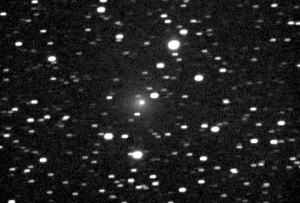Related Research Articles

Comet 4P/Faye is a periodic Jupiter-family comet discovered in November 1843 by Hervé Faye at the Royal Observatory in Paris. Its most recent perihelia were on November 15, 2006; May 29, 2014; and September 8, 2021.
56P/Slaughter–Burnham is a periodic comet in the Solar System with a period of 11.54 years.

60P/Tsuchinshan, also known as Tsuchinshan 2, is a periodic comet in the Solar System with an orbital period of 6.79 years. Tsuchinshan is the Wade-Giles transliteration corresponding to the pinyin Zĭjīn Shān, which is Mandarin Chinese for "Purple Mountain".

77P/Longmore is a periodic comet in the Solar System, with a period of 6.8 years.

78P/Gehrels, also known as Gehrels 2, is a Jupiter-family periodic comet in the Solar System with a current orbital period of 7.22 years.

11P/Tempel–Swift–LINEAR is a periodic Jupiter-family comet in the Solar System.

13P/Olbers is a periodic comet with an orbital period of 69 years. It fits the classical definition of a Halley-type comet with. The comet had last been seen in 1956 and the next perihelion is on 30 June 2024.

Comet Finlay is a periodic comet with an orbital period of 6 years discovered by William Henry Finlay on September 26, 1886. The next perihelion passage is July 13, 2021 when the comet will have a solar elongation of 54 degrees at approximately apparent magnitude 10. It last came to perihelion on December 27, 2014, at around magnitude 10. Of the numbered periodic comets, the orbit of 15P/Finlay has one of the smallest minimum orbit intersection distances with the orbit of Earth (E-MOID). In October 2060 the comet will pass about 5 million km from Earth.
18D/Perrine–Mrkos is a periodic comet in the Solar System, originally discovered by the American-Argentine astronomer Charles Dillon Perrine on December 9, 1896. For some time it was thought to be a fragment of Biela's Comet.
Comet 177P/Barnard, also known as Barnard 2, is a periodic comet with an orbital period of 122 years. It fits the classical definition of a Halley-type comet with. It orbits near the ecliptic plane and has aphelion near the Kuiper cliff at 48 AU (7.2 billion km).
178P/Hug–Bell is a periodic comet in the Solar System. It was discovered by Northeast Kansas Amateur Astronomers' League members Gary Hug and Graham Bell and is thought to be the first periodic comet to be discovered by amateurs. It was declared a comet less than two days after its initial discovery, after having its course confirmed on previous images.

Comet Kopff or 22P/Kopff is a periodic comet in the Solar System. Discovered on August 23, 1906, it was named after August Kopff who discovered the comet. The comet was missed on its November 1912 return, but was recovered on its June 1919 return and has been seen at every apparition since. Close approaches to Jupiter in 1938 and 1943 decreased the perihelion distance and orbital period. 22P/Kopff’s last perihelion passage was 18 March 2022. On 13 July 2028 it will pass 0.353 AU (52.8 million km) from Earth.

Comet Schaumasse is a periodic comet discovered by Alexandre Schaumasse on 1 December 1911 as 12th magnitude. It next comes to perihelion on 8 January 2026 and should brighten to about magnitude 9.
Comet Crommelin, also known as Comet Pons-Coggia-Winnecke-Forbes, is a periodic comet with an orbital period of almost 28 years. It fits the classical definition of a Halley-type comet with. It is named after the British astronomer Andrew C. D. Crommelin who calculated its orbit in 1930. It is one of only four comets not named after their discoverer(s), the other three being Comets Halley, Encke, and Lexell. It next comes to perihelion around May 27, 2039 when it will be near a maximum near-perihelion distance from Earth.

68P/Klemola or Klemola's Comet is a periodic comet, which belongs to Jupiter's comet family, that was discovered in 1965 by American astronomer Arnold Richard Klemola in Argentinian Yale-Columbia Southern Station. Its orbital period is 10.82 years.
122P/de Vico is a periodic comet with an orbital period of 74 years. It fits the classical definition of a Halley-type comet with. It was discovered by Francesco de Vico in Rome on February 20, 1846.

43P/Wolf–Harrington is a periodic comet discovered on December 22, 1924, by Max Wolf in Heidelberg, Germany. In 2019 it passed within 0.065 AU of Jupiter, which lifted the perihelion point and increased the orbital period to 9 years.
C/2000 W1 (Utsunomiya–Jones) is a long-period comet from the Oort cloud discovered on November 18, 2000, by Syogo Utsunomiya and Albert F. A. L. Jones. The comet reached up to apparent magnitude 5.5, but was only 27 degrees from the Sun in mid-December 2000.

62P/Tsuchinshan, also known as Tsuchinshan 1, is a periodic comet discovered on 1965 January 1 at Purple Mountain Observatory, Nanking. It will next come to perihelion on 25 December 2023 at around apparent magnitude 8, and will be 0.53 AU (79 million km) from Earth and 110 degrees from the Sun.
51P/Harrington is a periodic comet in the Solar System.
References
- 1 2 3 Seiichi Yoshida (2004-02-21). "20D/Westphal". Seiichi Yoshida's Comet Catalog. Retrieved 2012-02-20.
- ↑ "Horizons Batch for 20D/Westphal (90000306) on 2038-May-04" (Perihelion occurs when rdot flips from negative to positive). JPL Horizons . Retrieved 2023-02-11. (JPL#19 Soln.date: 2003-Apr-11)
- ↑ "JPL Small-Body Database Browser: 20D/Westphal" (1913-10-13 last obs). Jet Propulsion Laboratory . Retrieved 2012-07-26.
- 1 2 3 4 5 Sekanina, Z. (April 1984). "Disappearance and disintegration of comets". Icarus. 58 (1): 81–100. doi:10.1016/0019-1035(84)90099-X.

